|
Trooper Sydney Moore
144th Regiment Royal Armoured Corps, Normandy 1944
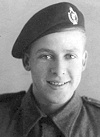
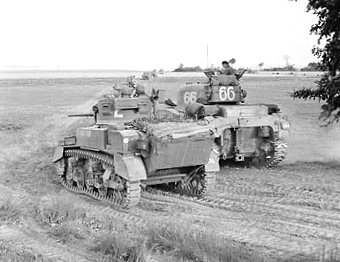
The main plan at that stage of the invasion was for the British to protect the Americans eastern flank near Caen as they headed for the port of Cherbourg. It was important to get another port operational so more troops and supplies could be landed. Montgomery needed a reserve of tanks that he could use against a German counter attack that headed for the coast. The 144th RAC regiment was part of Field Marshal Montgomey’s Armoured reserve.
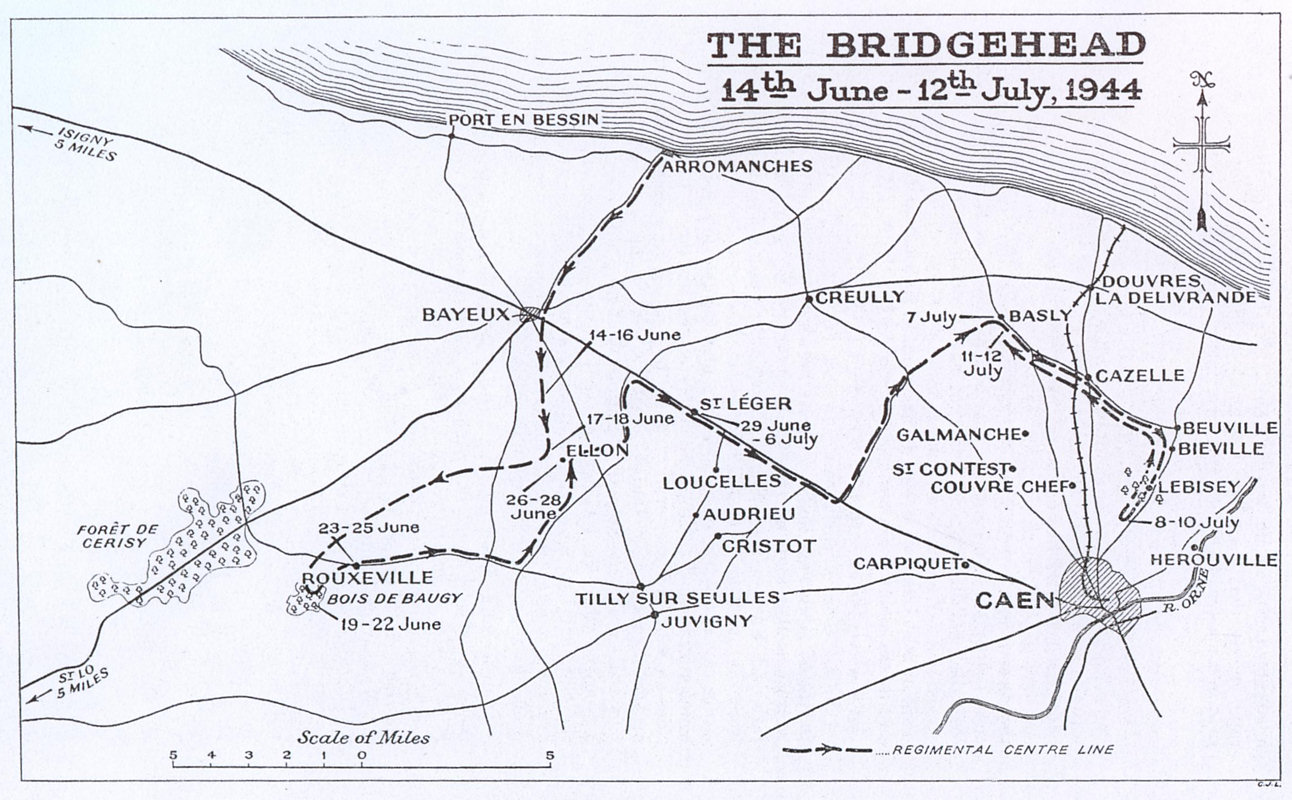
The first field was a too open and all the tanks were clearly visible from the air. On 17th June, as a precaution the regiment was moved to an orchard two miles further south. The tanks were ‘hidden’ under the trees. The troopers had to be careful where they pitched their bivouacs as the orchard was still occupied by a large herd of cows. The cow pats were just like land mines. Some of the tank crews picked a few apples and handed them around. The top of a tank is better than a ladder. Unfortunately all these apple trees produced cider apples and were sour.
On the 19th June the Regiment were ordered to relocate to an area of land called Bois de Baugy. The woods of Baugy. The tank crews called it Boggy Woods. It was south west of the Normandy village of Rouxeville. The heavens had opened again and the earth became very muddy. Tanks work best in open countryside. The enclosed dense woodland was not an ideal base for an armoured regiment. There were only a few tracks and roads in and out. If a tank got hit or broke down on one of those tracks the other tanks could not get passed it. They discovered some newly constructed German huts and a railway line. This turned out to be a V1 doodle bug rocket launching station under construction. For the lucky few the huts provided dry accommodation while the others tried to stay dry as best as they could. The only advantage of the wet weather was that the medical orderly ordered and extra ration of rum to keep the dampness at bay. Whilst waiting at this ‘harbour’ for new orders the crews were kept busy on gunnery practice.
New Regimental orders were received on 23rd June 1944. The 144th Royal Armoured Corps was to move to an area near the village of Rouxeville. The tank crews carried on practicing with their guns and making sure that they were ready to move out to deal with any German attack but no enemy contact occurred. On 26th June they were told to move to a new ‘harbour’ position. This time north east of Rouxeville near the village of Ellon. Again they were held here in reserve along with a Royal Artillery Regiment equipped with medium guns.
They were a back up force for Montgomery's Operation Epsom that had started
earlier that day. The objective of Operation Epsom was to advance towards the
village of Bretteville-sur-Laize and capture the high ground south of the city
of Caen. The Germans would be outflanked and hopefully lead the the City of Caen
being seized, The Allies did manage cross the River Oden and secure a foothold.
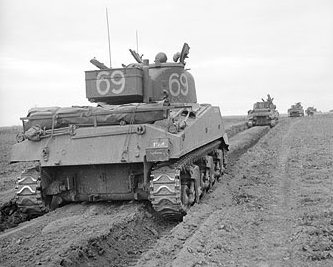
On 29th June 1944 news came of a break out by some German tanks. This strong
German counterattack was lead by the 1st and 2nd SS Panzer Corps. There was a big ‘flap’ on so they were rapidly deployed to a new ‘harbour’ just east of the village called St leger on the main Caen-Bayeux road. Each tank crew was shown where to place his vehicle if the Germans managed to break through the first lines of defence.
By the 30th June 1944 all the Allied Positions south of the River Oden had been
abandoned and the troops retreated back across the River. The Germans did not
attempt to cross the river the panic was over. Sid and his fellow tank crews stayed at this location for the next seven days, ready to deal with any
more German attacks.
On the 6th of July orders were received that the 144th were to act as reserve for the attack on the heavily defended city of Caen. The Allied planners had hoped Caen would have been captured by the end of the first day of the invasion. What they did not know was that the city and its outskirts was defended by the German 21st Panzer Division. After a month of bitter fighting, the various armies positions had not changed much since those of the 6th June.
Operation Charnwood was planed to start on 7th July. It was to be a frontal
assault by allied troops to capture the northern half of the City of Caen. On
the night of the 6th July 1944 Sid had to drive to a new position near the village of Basly. Overhead hundreds of Allied bombers flew and dropped bombs on Caen to soften up the target before the attack.
There was also a bombardment of the city by naval guns belonging to the Royal
Navy. Unfortunately many French civilians were killed. The tank crews moral was lifted by the bombing. They felt good, believing that their job would be easier because of the devastation that the bombs would bring down on the enemy.
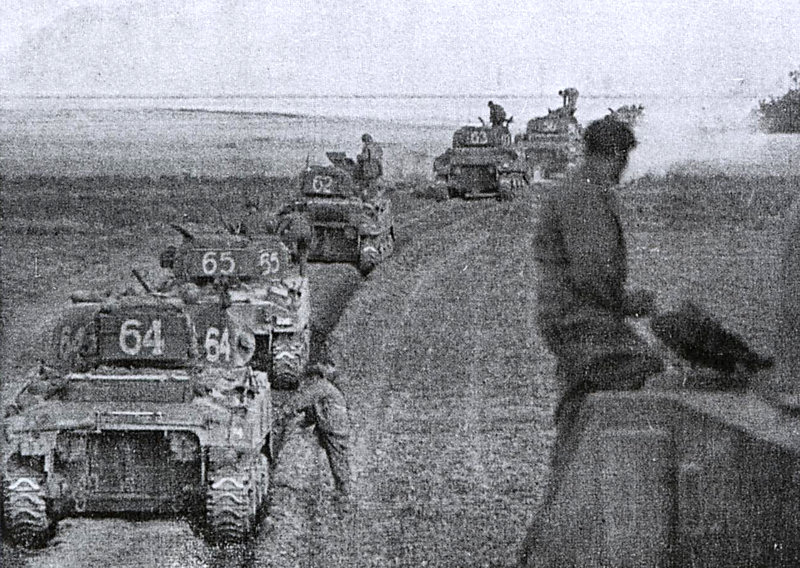
At noon on 8th July Sid and the other tank crews of the 144th were ordered to move forward through the village of
Cazelle to a position about two miles north of Lebisey. From here they would be able to back up any troops in trouble, who were fighting on the outskirts of Caen, quickly. The infantry had captured an important area of high ground that over looked Caen called Lebisey Wood. Sid’s crew and the rest of the regimental tanks were sent forward to defensive positions around the hill. There was lots of artillery shelling going on, mainly allied, throughout this time period.
The above photograph was taken of B Squadron 144th Regiment Royal Armoured Corps
on 8th July 1944l
On the 9th July A and C tank Squadrons were ordered to conduct an offensive reconnaissance of the village of Couvre-Chef near the north south railway Line. They discovered that it was empty
and no enemy soldiers could be seen. The infantry commanders would not believe them and ordered the tanks to retreat as they had ordered a carpet artillery bombardment of the area before they moved into the area. The infantry had taken a lot of casualties and did not want to take any more chances.
The tanks pulled back to the northern slopes of the Lebisey Wood high ground given the name of 60 ring contour. It was very unpleasant being this close to the front line. Sid and his colleagues were mortared intermittently. A number of troopers were injured from shrapnel. Luckily no one was killed. What was annoying was they could not retaliate but had to sit and endure it. On the 10th July one troop of B Squadron was dispatched to support the infantry capture the village of Herouville on the River Orne and the surrounding woods just to the North East of Caen. No enemy were encountered. On the 12th July orders were received to pull back in reserve to Basly.
Books that cover
Op Totalize are 'Blue Flash' written by Alan Jolly (p47 covers
Sid) & 'No
Holding Back' by Brian A Reid
|

